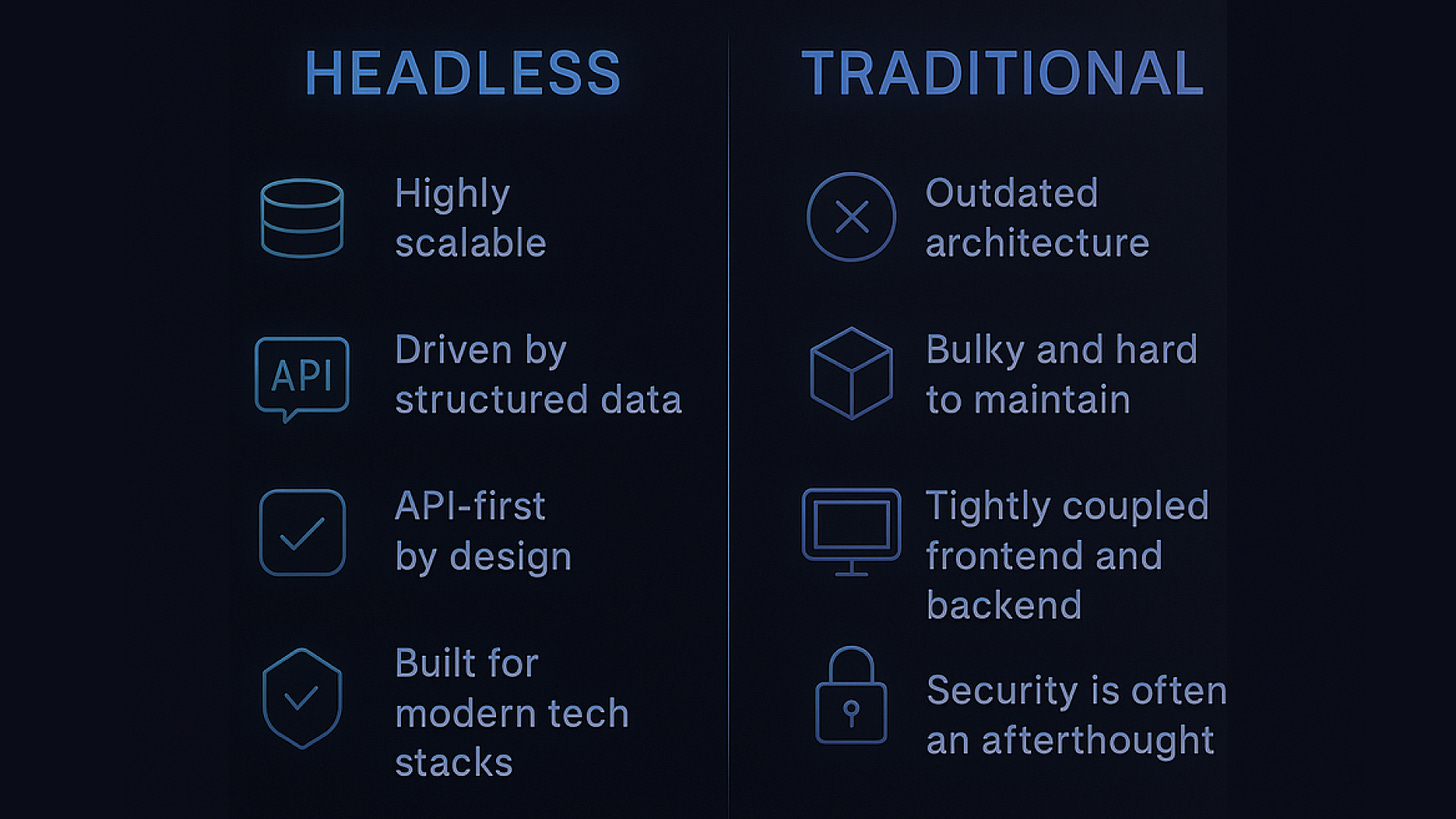In the ever-shifting digital landscape, content is no longer confined to a single format, platform, or user interface. Yet, many teams still rely on legacy CMS architectures that couple data with presentation in ways that feel increasingly outdated. Having spent the past five years working deep in the Strapi ecosystem — building some of the most adopted plugins under the Strapi Essentials umbrella and collaborating with global brands on highly complex headless and microservice infrastructures — I’ve seen one thing become clear: the traditional CMS is no longer enough. If you're architecting for scale, flexibility, or true omnichannel distribution, it's time to go headless. Not as an experiment, but as your default.
Separate Data from Presentation — For Real This Time
One of the fundamental strengths of headless architecture is the strict separation between content and its presentation. In traditional CMS platforms, the way data is stored is tightly coupled with how it’s rendered — typically inside monolithic systems that assume a one-to-one relationship between backend and frontend. This worked when content lived primarily on a single website, but it becomes a huge constraint when you want the same data to power a mobile app, a smart TV, or a smartwatch interface.
With a headless CMS like Strapi, you define structured content models — think of them like schemas for blog posts, product data, or even user-generated content — and expose them via API (REST or GraphQL). The frontend, whether it’s built with React, Vue, or native mobile technologies, simply consumes that data. This gives you complete freedom in how you design and deliver the frontend experience. You can even build multiple experiences off the same dataset, without duplicating or reworking your content structures. In my work with global retail platforms and multi-brand publishers, this decoupling has consistently been the foundation of scalable systems that evolve without tech debt.
Total Stack Independence — Mix and Match Your Tools
When you're no longer locked into a rigid backend–frontend combo, your tech stack opens up. In a headless setup, your frontend doesn't care if your backend is in Node.js, Go, Python, or Rust. You can change one layer of the stack without touching the other. This modularity lets you evolve at your own pace, integrate best-in-class tools, and iterate without fear of breaking the whole system. It also means you can mix tools that play to your team’s strengths or your business's unique constraints.
Over the years, I’ve worked with organizations where the frontend is built in Next.js for the web, while mobile apps pull from the same Strapi backend using GraphQL. In some cases, data gets piped into external systems like Algolia for search, or into analytics pipelines for real-time insights. The architecture becomes a constellation of services — decoupled, focused, and composable — rather than one bloated system. And that’s a massive win for agility and long-term maintenance.
Performance, Cost, Efficiency — Modern Rendering Models That Work
A lesser-discussed advantage of going headless is the performance and efficiency it brings, particularly when combined with modern rendering approaches. Take Isomorphic Web Applications as an example — these are apps that run both on the server and in the browser, offering the benefits of server-rendered speed with client-side interactivity. Frameworks like Next.js and Astro exemplify this approach. They can statically pre-render content at build time (Static Site Generation), serve it instantly via CDN, and hydrate the frontend dynamically for a seamless UX.
Similarly, SSR (Server-Side Rendering) — where pages are rendered on-demand per request — still benefits heavily from a headless setup. Here, the CMS is only queried during page generation, not on every user interaction, which minimizes backend load and optimizes CDN usage. In both cases, your CMS doesn’t need to be “always on.” It acts more like a static generator, or a headless data layer — reducing infrastructure costs significantly, especially at scale.
From an efficiency standpoint, this model is also easier to cache, cheaper to host, and more resilient to spikes in traffic. Your operational footprint shrinks dramatically: less backend compute, fewer moving parts during runtime, and a much simpler DevOps model. I’ve implemented architectures where Strapi is only called during revalidation or regeneration events, yet serves millions of users with minimal latency and a near-zero backend bill. This is modern efficiency at its best.
Omnichannel Distribution Built In
One of the killer features of a headless CMS is its built-in support for multichannel content distribution. Whether you’re targeting web, mobile, native apps, kiosks, digital signage, voice assistants, or social media bots, a headless CMS doesn’t require any special integration tricks. Since content is exposed through APIs by default, pushing it to multiple outputs becomes a question of architecture, not a workaround. This native readiness for multichannel publishing is critical in today’s fragmented digital ecosystem.
In my own projects, I’ve helped media and commerce clients centralize their editorial workflows into Strapi, and from there deliver personalized content to React web apps, React Native mobile apps, smart mirror displays, and even in-store POS systems. Everything is powered by a single source of truth. And thanks to the clean separation of concerns, changes in presentation layers — like a new app design or a replatformed frontend — never require migrating or rewriting content models. It’s simply a better, future-proof way to work.
Why Strapi, and Why I Bet On It
There are many headless CMS options out there — Contentful, Sanity, Directus, Storyblok, to name a few — but I continue to bet on Strapi for a few key reasons. First, it’s open-source and self-hosted by default, which means full control over your infrastructure and data. It’s not locked behind a paywall or proprietary stack. Second, it’s genuinely extensible. You can build custom plugins, policies, lifecycles, and even swap out core services. The Strapi Essentials plugin suite was born from this flexibility, and is now used by developers globally to speed up real-world projects. It is constantly maintained and expanded by a team of experts working closely with me at VirtusLab — where we've long been regarded as leaders in this space. Recently, as part of the broader VL Group, we also launched a narrowly focused tech-boutique called Sensinum, dedicated to solving exactly these kinds of challenges through our deep and specialized expertise in headless architecture, content engineering, and modern platform design.
Strapi also strikes a rare balance between developer-first experience and enterprise readiness. It supports role-based access control, both REST and GraphQL APIs, internationalization (i18n), dynamic zones for flexible content types, and has a highly active community around it. I've used it in high-availability, mission-critical systems that had to integrate with multiple services, scale horizontally, and remain compliant with strict governance requirements. It hasn’t failed me.
If you’re building for the modern web — with its mix of devices, touchpoints, and experiences — you owe it to yourself to architect with the future in mind. Headless isn’t just another option on the menu. For most serious content-driven applications, it should be the default. You gain agility, performance, integration power, and true independence from vendor lock-in.
And if you’re wondering where to start — I’ll say it plainly: Start with Strapi. It’s the tool I trust, the ecosystem I’ve helped shape, and the platform that’s enabled some of the most ambitious headless builds I’ve been part of. It’s not just a CMS. It’s your content infrastructure for the next decade.






